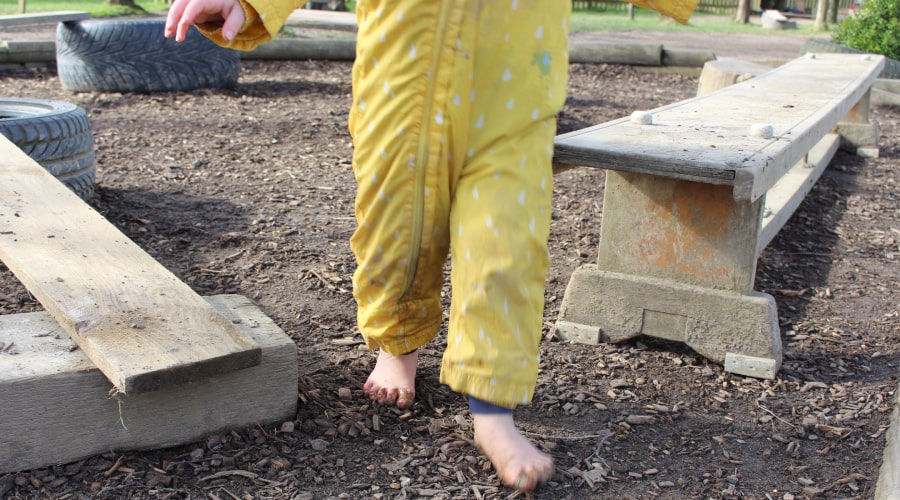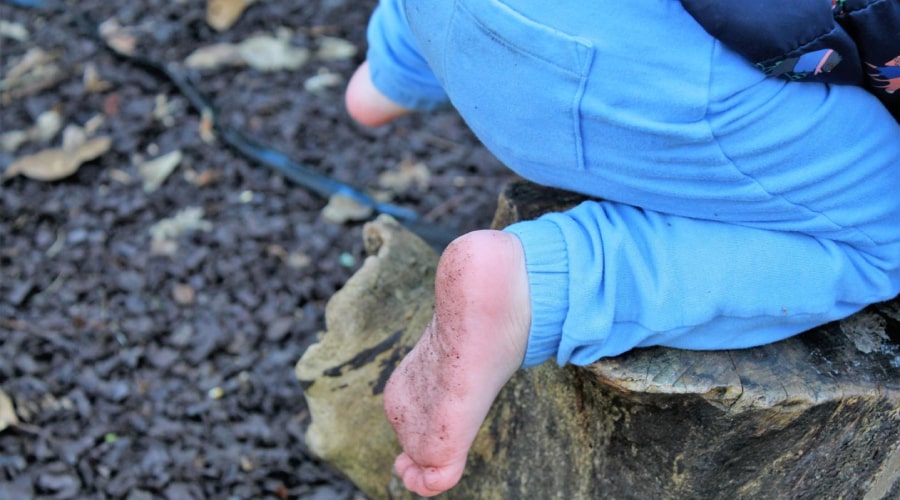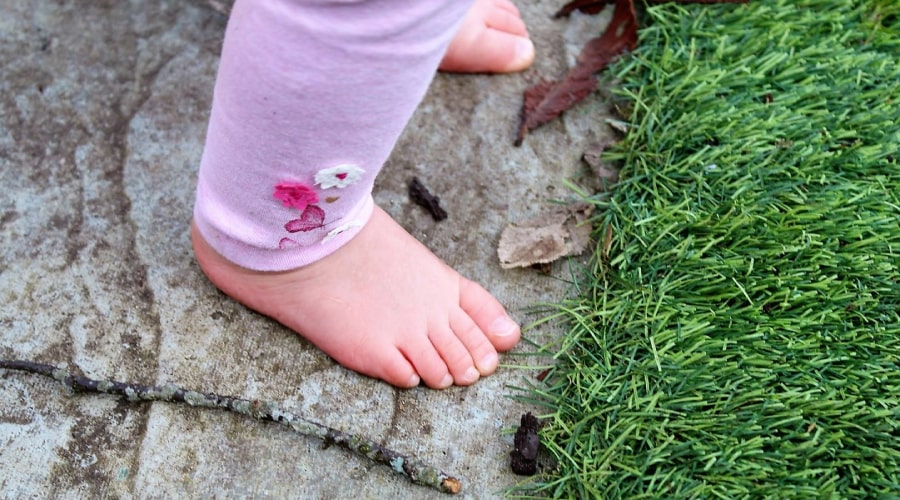settings
children
With Famly since
Have you ever seen a toddler bumbling along, looking at their little shoes, until they topple over?
Despite it being downright adorable, it’s actually an indicator that they would be better off with bare feet.
Having bare feet means budding walkers can look out on the path ahead, instead of down at their toes to see what’s happening, as they’re allowing their feet to feel the way. This proprioception (your body's ability to sense movement, where you are, and how you’re moving) leads to improved balance and jumping skills later on.
So why are we still tucking those tiny toes away?
Well, they aren’t at Little Barn Owls.
I sat down with two of the Little Barn Owls team, and their Head of Children's and Adult's Learning, Kerry Smith, to find out how they introduced barefoot play as a permanent part of their provision.
So, if you’re wondering how to get your children (and your team) on board with taking off their shoes, you're in the right place.
Best foot forward…

Starting off on the right foot
“When the leadership introduced it, I was actually a little bit unsure,” says Practice Leader, Katrina.
But leadership took the time to explain why they wanted to try barefoot play and the benefits (more on that here). Knowing the ‘why’ can turn your team into the best advocates of new practice, so they can explain the reasoning to parents.
“Get your team on board,” advises Pedagogical Coordinator, Kevin. “I went into all the rooms and explained that this is what we’re going to do and why we’re doing it. It’s about getting them involved. I collaborated with the team and they helped to set up what we were doing for the children. And the educators were having fun exploring it too!”
Once educators were ready to lose the shoes, the next step was introducing it to the parents.
Share with the parents
“Some of the parents were uneasy at first,” says Katrina, “But once I explained why we were doing this, they felt more at ease.”
And not only that, Katrina shared how it was already benefiting the children.
“I told them how I’d watched their children's confidence grow, which parents love to hear about. Now, some of the children are doing it at home with their parents too, so it helped build up a dialogue between us and the parents.”
The team were also careful to explain how they keep the children safe while they’re outside with bare feet..
“We have a daily written risk assessment,” says Kerry, “So one of the educators will always go out and check the garden and manage any risks or dangers, knowing we do barefoot play. We spoke to the leaders, especially, about being mindful of what’s on the floor.”
By working with parents, the LBO team were then able to promote barefoot experiences to the less confident children. For example, parents had shared that some of the children didn’t like the feeling of sand between their toes at the beach, so the team offered a Tuff Tray full of sand, and combined it with other sensory play which was more familiar to the children.
The team were also keen to celebrate the children’s achievements and share their ongoing progress with parents too.
“We use Famly, so we shared photos, quotes, and observations of how much fun the children were having and how engaged they were in the sessions,” says Kevin, “So when the parents came to me at the end of the day, they said how much they [the parents] loved it and that it’s fantastic. It was a positive experience for the parents, as they could see their child had fun. They could read the children’s own opinion of how it felt and see their reactions for themselves.”

The socks come off
When the team first introduced barefoot play to the children at Little Barn Owls, they broke it down by age. As the babies hadn’t gotten used to wearing shoes outdoors yet, their barefoot experience began outside. But for the older children, Katrina built it up slowly, in stages.
- First she brought the outdoor textures inside, because that’s the environment where children were already comfortable having bare feet.
- Then, Katrina continued the indoor barefoot sessions over several weeks, bringing in tuff-trays of grass, stones, bark chips, sand, mud, and leaves for the children and the educators to try.
“We took our shoes off as well,” explains Katrina, “So the children could see we were confident about doing it too. You have to be open-minded and be a role model.”
- Next, she introduced climbing with bare feet indoors, so children could practise this before the transition outside.
Kevin adopted a similar strategy to support children out of the tuff trays, once they were in the garden.
“I asked the children to do little tasks, like ‘Could you go and pick up those binoculars?’ and they jumped up and walked to the things I’d asked them to collect. Before I knew it, they were confidently walking in the garden with bare feet.”
“Don’t make a big thing of it,” advises Kerry, “As Kevin says, turn it into a task that children can do while barefoot, so the focus isn’t only on having bare feet.”
It’s also important that children have ownership of the process. For example, there is no rule about where to leave your shoes or when to take them off. Children can choose to remove their shoes inside and then go out or take them off outside.
“The children feel more comfortable as they have the independence to take their shoes off themselves and then they know where they are. We wanted to make it as easy as possible for them.” explained Katrina.

Thinking on their feet
Educators at Little Barn Owls have seen a phenomenal amount of learning and development as a result of barefoot play.
“There was one child, who I’d never seen climbing who, in stages, climbed up a log and stood confidently on top of it,” says Kevin, “He found his balance without any educator support. It was such an achievement for him and it was lovely to see him build his confidence.”
But it’s not just an increase of confidence. The children have engaged in problem-solving too.
“A little girl had taken her shoes and socks off in the sandpit and then walked across the garden. But, she didn’t like the feeling of the woodchip underfoot.” says Kevin, “Unfortunately, she didn’t establish this until she was halfway across. But she didn’t get upset, she just started wiping away the bark with her hands. An educator asked her what she was up to, and she explained what she was doing, that she didn’t like the feeling of the bark, so she was making a path for herself.”
The team have also noticed how the children are gaining independence about removing or putting on their shoes and socks, and have observed the children helping one another.
“There were a group of girls in the sandpit at our Farlington site, who’d taken off their shoes and socks at the sandpit, so they could jump in,” recalls Kerry, “Then another little boy came over, and one of the girls told him ‘You can take your shoes and socks off, you know.’ Then she sat and took his shoes and socks off for him and put them next to hers, by the sandpit. It was amazing to see that collaboration.”
It’s been so well received by the children, in fact, that some don’t want to put their shoes back on.
Kevin says, “We have one little girl who now won’t wear shoes at all outside!”
You can find out more about Little Barn Owls and how they do barefoot play here.
The big ideas
Get 1000s of free EY activities
Want over 7,000 activities? See them in a free 14-day trial. Filter to target learning areas, age groups and topics, and get inspired.
Get started









